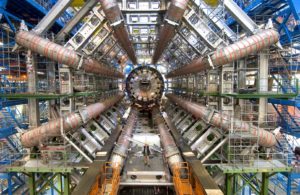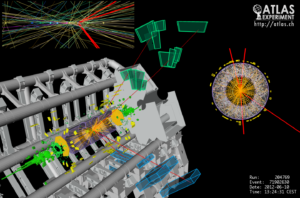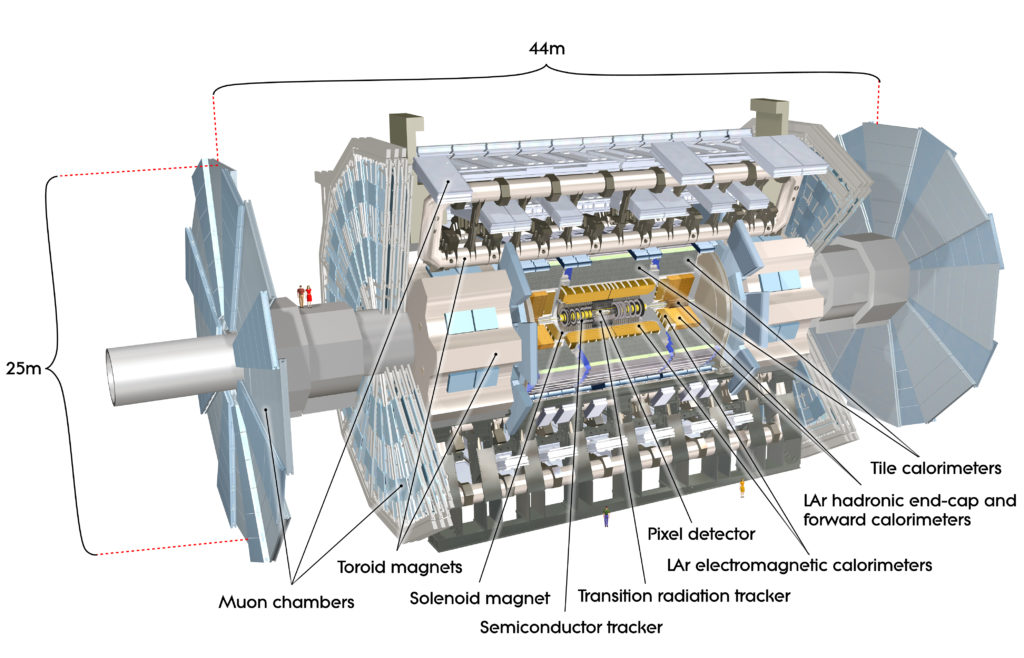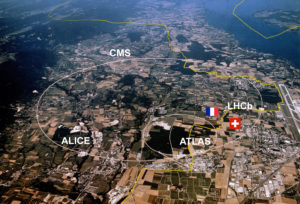PageContent
ATLAS experiment

Local Responsible: Maximiliano Sioli
National Responsible: Stefano Giagu
ATLAS (A Toroidal LHC ApparatuS) is one of the major experiments at the Large Hadron Collider (LHC), at CERN, Geneva. It is an experiment run by an international collaboration and, together with CMS, it has been designed to study all the aspects of the physics of proton-proton collisions at the highest energies available today.
The experiment aim to probe the matter down to the fundamental constituents of matter to push more and more the frontiers of knowledge by seeking answers to fundamental questions about elementary particles which build the matter, the interactions among them and whether there could be a wider symmetry in our Universe.
+ Research activities However, identifying and studying in detail the phenomenology of this particle are not the only two goals of the ATLAS collaboration researchers. Indeed, they are involved in searching phenomena beyond the SM predictions (for example the dark matter or the Quark-Gluon Plasma) and in developing new theories (for example Supersymmetry, String theory, theories of Great Unification) which could answer some open questions of the SM and, consequently, better describe our Universe.

+ Location and detector structure The “onion-structure” of the detector aims to detect the tiniest and most energetic particles ever created on earth. The six different sub-detectors are built concentrically to the interaction point in order to record in real time the trajectory, the momentum and the energy of the particles, allowing physicists to identify and measure all the interesting characteristics. The magnet system is crucia for this goal, bending the charged particles trajectories and, consequently, identifying the momenta with great precision.
Its may-layered structure is typical of “multi-purpose” detectors, built with several different materials, with a cilindrical shape, wrapped concentrically in layers around the collision point in the tube (along the axis), where bunches of protons (or heavy lead ions, Pb) are accelerated and collide in the interaction point, located precisely in the center of the detector. It is composed by a “tracking” system, solenoidal superconducting magnet, an electromagnetic calorimeter, an adronic calorimeter and a superconducting toroidal magnets. Around the magnets system, the last layer can be found: a large spectrometer composed by a series of gas detectors for tracking and identifying muons.

+ The collaboration and the Bologna group The Bologna group is part of this wide international collaboration since 2005, with around 50 components (physicists, technologists, technicians e doctoral students). The groups started its collaboration with ATLAS through three main activities: the design and construction of the LUCID luminosity detector, the realization and test of the trigger system for the muon spectrometer and the test of some chambers of this sub-detector (RPC), integrating, later during the years, these activities with the electronic design of the Pixel inner detector and with the development of the RPC chambers for the muon detection. The group is, moreover, heavily involved in several activities of physics analysis of events collected by the ATLAS detector, in many areas in collaboration with colleagues from other institutes. In the SM sector, the group is involved in the precision measurements regarding especially the Z boson. In the Higgs boson sector, it is involved in the study of the properties and, specifically, of its couplings with top quarks and vector bosons, focusing on the decay channel into two bottom quarks. The group has been involved, moreover, into analyses of the top quark, having a ten years experience in inclusive and differential cross section measurement of the top-antitop quarks system at different energies.
In sight of the next data-taking, called Phase-1 (2021-2024), the group is involved in the design of a new-generation RPC chambers, pioneering project for the detector upgrade scheduled for the High Luminosity LHC (starting from 2026), when the instant luminosity provided by LHC will increase of a factor 4. These new conditions impose a substancial upgrade concerning the whole experiment. In this area, the Bologna group is involved in the upgrade activities for the muon spectrometer, in the construction of a brand-new luminosity detector, in testing a significant fraction of the new tracking system (ITk) sensors and in Data Acquisition and Trigger (TDAQ) activities.
The ensemble of these strumental activities has been extended, more recently, to computing activities as well.
In the physics beyond the SM sector, the group is involved in different analyses aiming to test the existence of particles predicted by Supersimmetric and “exotics” models, to probe possible answers for the still opened questions of the SM.
Sito web del gruppo di Bologna
ATLAS web site
Sito web di ATLAS Italia












